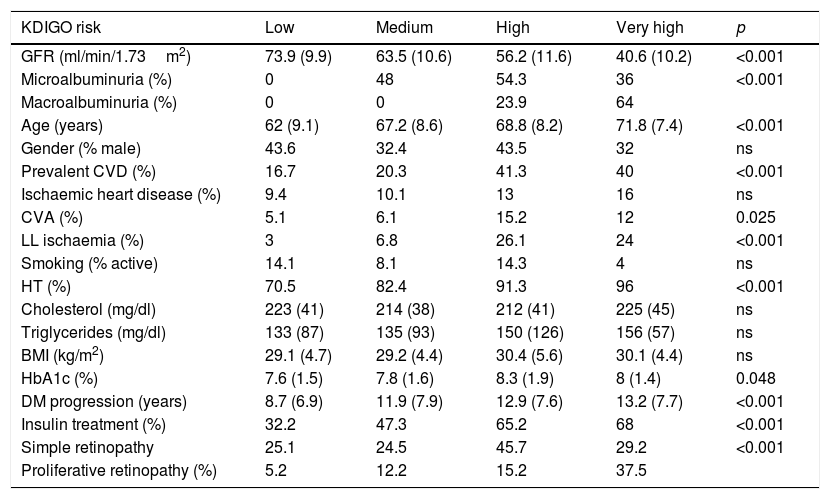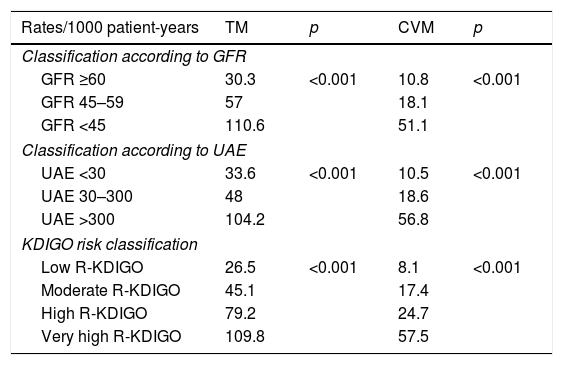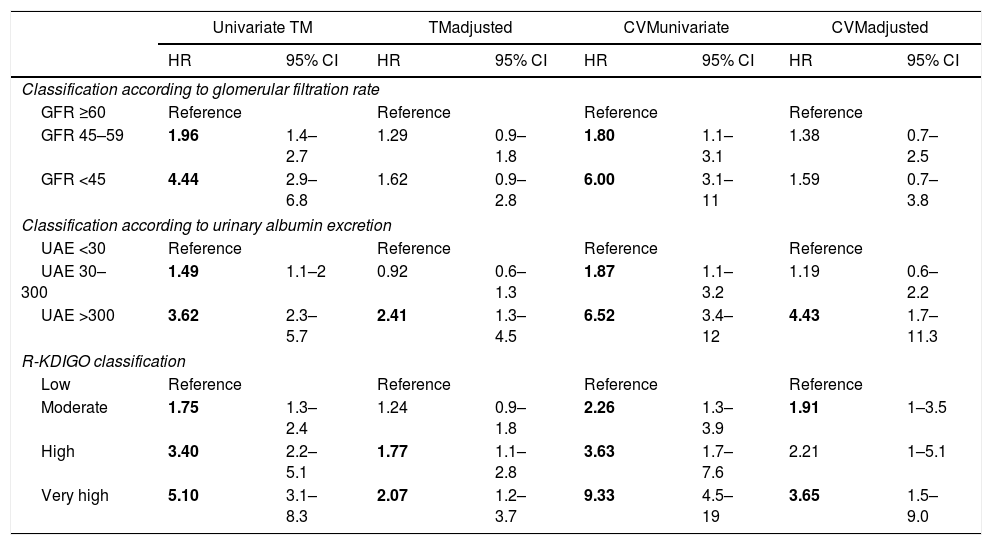Our aim was to assess the usefulness of KDIGO 2012 risk classification to predict total and cardiovascular mortality in type 2 diabetes mellitus (DM2).
Material and methodsProspective cohort study that included DM2 patients. Clinical end-points were total and cardiovascular mortality. The main predictive variable was KDIGO risk classification, which is a combination of urinary albumin excretion and glomerular filtration rate. The predictive value was evaluated by the integrated discrimination improvement (IDI) index.
Results453 patients (39.3% males, aged 64.9 [SD 9.3] and with a mean diabetes duration of 10.4 [SD 7.5] years) were included. During a median follow-up of 13 years, mortality rates per 1000patients/year (26.5 vs. 45.1 vs. 79.2 vs. 109.8; p<0.001) and cardiovascular mortality (8.1 vs. 17.4 vs. 24.7 vs. 57.5; p<0.001) were progressively increased in successive KDIGO categories. In the multivariate analysis, there was also a progressive increase of mortality risk (HR[moderate risk]=1.29; HR[high risk]=1.83; HR[very high risk]=2.15; p=0.016) and cardiovascular mortality risk (HR[moderate risk]=1.73; HR[high risk]=2.27; HR[very high risk]=4.22; p=0.007) in the successive categories. KDIGO classification was able to improve the mortality risk prediction (IDI=0.00888; p=0.047) and cardiovascular mortality risk prediction (IDI=0.01813; p=0.035).
ConclusionsKDIGO risk classification can effectively stratify total and cardiovascular mortality risk in DM2 patients.
El objetivo del estudio fue comprobar la validez de la clasificación de riesgo KDIGO 2012 para predecir mortalidad total (MT) y cardiovascular (MCV) en diabetes mellitus tipo 2 (DM2).
Materiales y métodosEstudio de cohortes prospectivo incluyendo pacientes con DM2. Los puntos finales clínicos fueron MT y MCV. La principal variable predictora fue la clasificación KDIGO, una variable que recoge 4 niveles de riesgo en dependencia de una combinación de la tasa de filtración glomerular y la excreción de albúmina urinaria. La evaluación del poder predictivo se realizó con el índice de mejora de discriminación integrada (IDI).
ResultadosSe incluyeron 453 pacientes (39,3% varones, edad 64,9 [DE 9,3] años y evolución de DM2 de 10,4 [DE 7,5] años). Durante una mediana de 13 años de seguimiento, hubo incremento significativo de la tasa/1000 pacientes-año de MT (26,5 vs. 45,1 vs. 79,2 vs. 109,8; p<0,001) y de MCV (8,1 vs. 17,4 vs. 24,7 vs. 57,5; p<0,001) en las sucesivas categorías de riesgo KDIGO. En análisis multivariante también hubo incremento de riesgo de MT (HR[riesgo moderado]=1,29; HR[riesgo alto]=1,83; HR[riesgo muy alto]=2,15; p=0,016) y MCV (HR[riesgo moderado]=1,73; HR[riesgo alto]=2,27; HR[riesgo muy alto]=4,22; p=0,007) en las sucesivas categorías. La clasificación KDIGO mejoró la predicción de MT (IDI=0,00888; p=0,047) y MCV (IDI=0,01813; p=0,035).
ConclusionesLa clasificación de riesgo según guías KDIGO 2012 puede estratificar eficazmente el riesgo de MT y MCV en pacientes con DM2.












